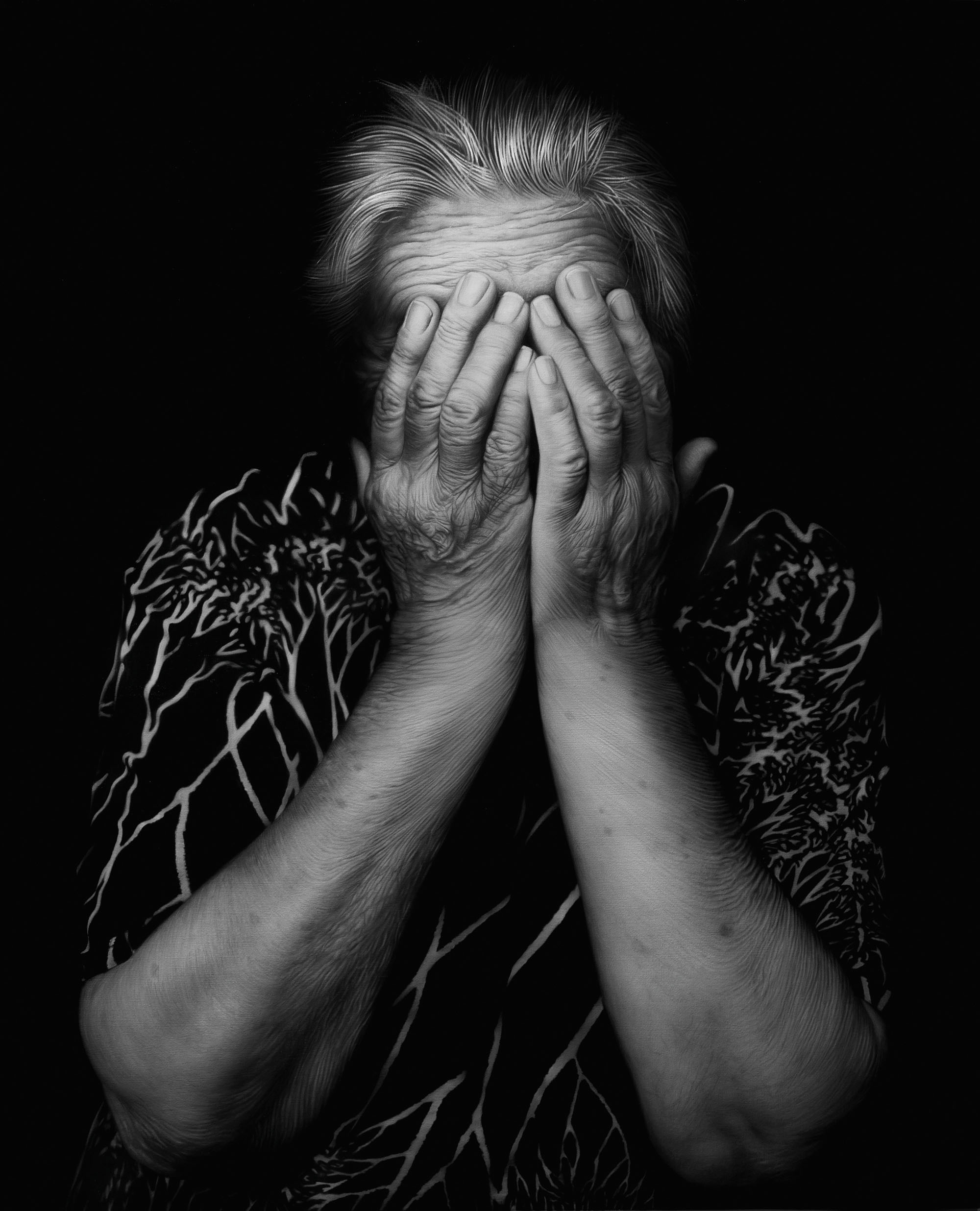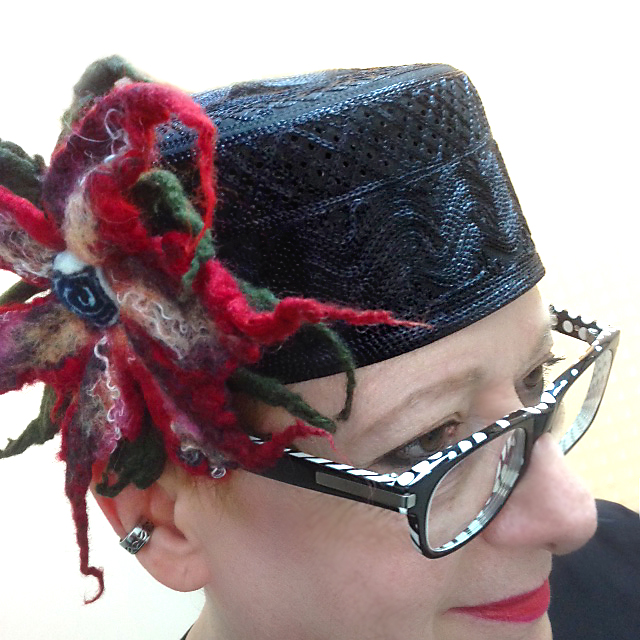Tigran Tsitoghdzyan is a master of holding a mirror to the human condition. He does this by painting hyper-realistic, often monumental canvases that are in your face, yet seem a million miles away. With their ultra-photographic precision, hence clear-cut manifestness, these works gaze at you with a strange familiarity, imploringly, empathically, yet without judgment, while they offer you any number of keys to introspection without ever prescribing method or pathway. That’s because Tsitoghdzyan, as both an artist and a thinker, is only too aware of the marvelous fluidity, therefore ultimate intractability, of the human psyche. He knows to leave well enough alone, while ferociously, stubbornly and silently pursuing the secret language of its beating heart.
Tsitoghdzyan’s “Mirror” series is among his most prominent. In these monochromatic works, which mostly depict women, he recreates photos of close-up facial portraits, then overlays them with the models’ hands, thus covering their faces with their facial features bleeding through. Among Tsitoghdzyan’s most indelible works are several series dedicated to life on the eve of the 2000s, with titles such as “Millennium” and “Connection,” and paintings such as “Occupy Wall Street.” In these often-allegorical works, Tsitoghdzyan zeroes in on our tech-driven socio-political landscape, while liberally channeling the luminaries of art history, like a young man heeding the advice of a wise elder.

Tsitoghdzyan lives and works in New York. Born in Yerevan in 1976, he had his first exhibition at the age of ten. The 100 paintings in that show traveled from Yerevan to the US, Russia, Japan and Spain. Tsitoghdzyan went on to exhibit his works in these countries and across Europe. After graduating from the Yerevan Academy of Fine Arts, Tsitoghdzyan received a master’s from L’Ecole cantonale d’art du Valais in Switzerland. In addition, he completed artist residencies in England and South Africa.
Today, many of Tsitoghdzyan’s works are part of private collections, as well as permanent collections of museums and galleries across the globe. Tsitoghdzyan and his work are featured in the award-winning 2018 film American Mirror: Intimations of Immortality alongside Susan Sarandon.
I spoke with Tsitoghdzyan in Yerevan on the occasion of his forthcoming exhibition at the Nur Art Gallery on August 22.
Sona Hamalian: Although sharing some basic compositional elements, the works in your “Mirror” series seem to be open to a myriad of readings or interpretations. What was the driving force behind the creation of this series?
Tigran Tsitoghdzyan: As an observer and someone who works with portraiture, I had to react to the selfie phenomenon. It took over the social media, and the filters era began. I was fascinated by the desire for self-exposure, but it became very controlled. So I started to paint filtered female large portraits the way they, the subjects, want to be seen by others. In this situation, I’m playing the role of the filter. Regardless, the repetitive self-exposure, the subject, is hiding behind the boundaries of the controlled image and filters.
S.H.: In your painting titled “Censored,” the female subject is hiding her face with her hands, as though to protect something from prying eyes. By contrast, the female subjects in the “Mirror” series have their hands overlaid on their faces, without hiding them. What do you see in these variations?
T.T.: It was a period of my life when I was questioning the female as the “other” alienated subject that is a mystery and attractive at the same time. Painting that series of works was a questioning myself about the perspective of emerging with it, and blowing it up to a very large scale was the opportunity to spend time with details that you never have time to observe in real life and time.
S.H.: In “ paintings in which you depict the intensifying phenomenon of technology driving human life, you reference the Madonna and Child to underscore the point. In compositional, intellectual, and emotional terms alike, why do you think a given subject matter becomes even more powerful when viewed from the prism of the art of the past?
T.T.: Art has been changing its functions through the history of art. Renaissance painting idealized religious and social values. Today, we are living in the era of a technological renaissance. I was invited to Florence to mount a solo show, and decided to showcase modern family values in the traditional Florentine painting language and the layered oil technique. I replaced the religious icons with today’s technological ones. Thus the disconnection between the mother and the child, and “in device isolation,” is taking space inside the traditionally round paintings that used to glorify the saints.
S.H.: Your painting titled “Occupy Wall Street” serves up biting commentary on social injustice with a polo player representing a lifestyle that’s in stark socio-economic contrast to the daily struggles of the masses. Would it be fair to say that New York and its quintessential energies loom large in your works? Also, how does New York figure in your world view in general?
T.T.: During the “Occupy Wall Street” manifestations, I saw the horse police on a daily basis around my building, as a resident of Wall Street. Then I was invited to the Hamptons for a Polo charity event, and it was such a social contrast, with the opposite problems (the problems of the rich and powerful) being discussed around me. So I thought, what if I merge the horses from the polo game and make them meet those who have 9-5 jobs with the New York Police Department, in my neighborhood. I donated that piece for charity.

S.H.: “Armenian Mirror” is perhaps one of your most strikingly evocative yet enigmatic works. What can you tell us about the subject?
T.T.: I wanted to paint today’s Armenia portrait. I came across a very old lady at a retirement home. She had amazingly beautiful Armenian eyes. But in the painting, which was drawn in 2015, you can’t see her eyes as she is closing her face with her two hands. I wanted to paint an Armenian grandmother, one who had seen a lot and had so many stories and tales to tell, yet she chose to hide her face vis-à-vis the social and political realities of her day. She is a universal grandmother to all Armenians, one with whom all of us can identify.
I think today she would start showing her beautiful face as the changes in Armenian society are visible on the faces in our streets. I’ve never seen Armenia as positive and welcoming as today, and I’m just an observer.



Be the first to comment